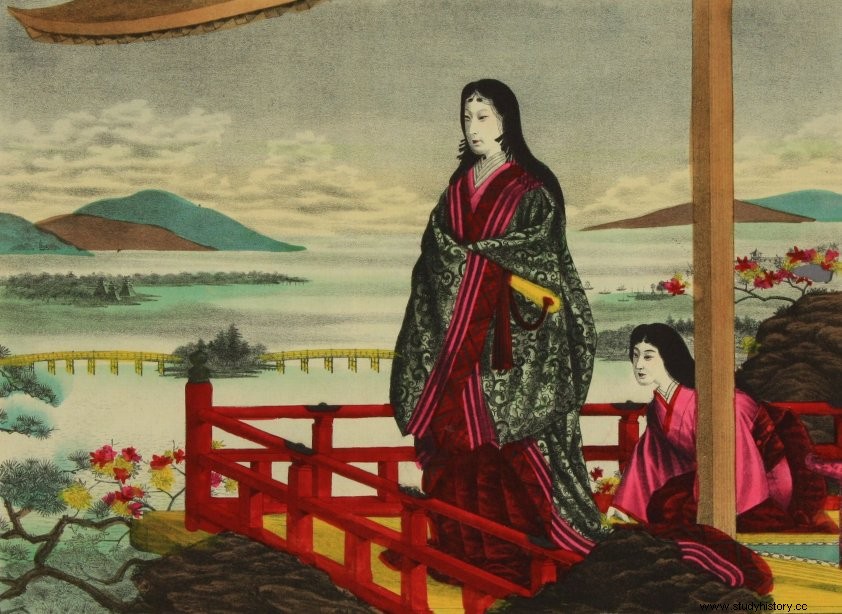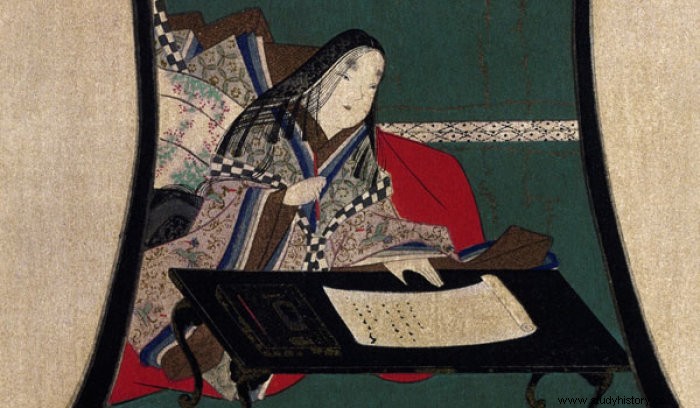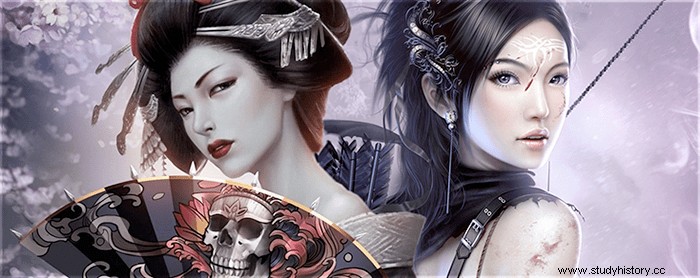It comes from When Yin Triumphed Over Yang in Japanese Literature…
Murasaki Shikibuki He was born around the year 973, in the bosom of the powerful Fujiwara family, and thanks to this he received a careful education. His father, a poet and scholar, taught him the Chinese classics, which was originally reserved for boys. The little girl's ability for letters was impressive. A few years later, barely past her teens, she would begin to write what would become one of the fundamental works of universal literature, the famous Genji Monogatari (The Tale of Genji). Considered the first novel in the history of mankind, the Genji Monogatari is a monumental work where practically everything fits. The love affairs and escapades of Prince Hikaru Genji, the protagonist of the story, are nothing but an excuse to show us a rich mosaic that contains in itself the entire universe of classical Japan. Life at court with all its greatness and its miseries. A total of sixty-five chapters condensed into more than a thousand pages of novel even in its most abbreviated editions. And all this 500 years before, in the other part of the world, the good Don Miguel de Cervantes learned to write the alphabet. The Genji Monogatari would become a best seller in its time, and it was surely that popularity that opened the gates of the palace to Murasaki. In fact, it may be that her own alias, Murasaki, is an homage to a certain homonymous character who appears in the novel and who has always been suspected of being an alter ego of the author herself. Be that as it may, around the year 1005 Murasaki becomes part of the entourage of the empress Shoshi , and she will be within the palace walls where she will meet her literary nemesis, the lady Sei Shonagon .

Murasaki Shikibu
Murasaki and Sei, like a Góngora and a Quevedo from ancient Japan, were staunch rivals. And, no matter how delicate their verses were, they were not shy about throwing taunts at each other whenever they could. Beautifully written taunts, of course. One cannot expect less from two glamorous and refined ladies like them. The court of Kyoto was to experience a most artistic duel between two superior intellects, two of the most brilliant minds that the centuries had ever seen. And almost a millennium later, the lucky readers of the 21st century can also enjoy these dialectical fencing ventures thanks to the writings that both have left us.
Unfortunately, from the other protagonist of this summit fight, Sei Shonagon We don't know much. Apart from the stab wounds that Murasaki dedicates to her in her works, the little we know about Sei is what she herself tells us in her own diary. That same diary that is her magnum opus and one of the pinnacles of Japanese letters. The famous Pillow Book that so fascinated Jorge Luis Borges, and that has had a major influence on the formation of the Japanese language as we know it today. The Pillow Book It is much more than just a diary. Its name alludes to the Heian-era nobles' custom of keeping packs of paper next to their pillows to take notes at any time. In the form of simple jottings, Sei portrays the vicissitudes of court life with a brilliant style and photographic precision. Always from her particular point of view, of course, with high doses of irony and sharpness.

Sei Shonagon
Sei she wrote about everything divine and human and she did not hesitate to turn green whoever she did not like or raise to the heights whoever she liked. Without going any further, her lovers, who she had in large numbers, do not usually come out very well. For example, she always complains that, after having fulfilled in bed, they begin to snore uncontrollably. And she is extremely irritated that they do not know how to leave her chambers with the proper stealth at dawn, as she should do every self-respecting gentleman. There are also some, especially farmhands, who forget about her until they write to her the next day to thank her for her evening. The height of indelicacy. Our seasoned social chronicler, who had entered the court of Empress Teishi Shortly after his divorce, barely twenty-five years old, he always swore and perjured that he never wrote his diary with the intention of making it public. But, coincidences of life, she ended up being the preferred bedroom reading of all the nobility of Kyoto. Which, in the end, earned Sei her passport to stardom in the Heian era. . And to not a few Casanovas from the capital, he would serve as a reference work, of incalculable value, to know what not to do when hanging around the damsel on duty. Because not calling the next day (or writing, if cell phones don't exist yet) is very ugly, here and in Japan.
In addition to these two immortal works, written in prose, the poems of Murasaki and Sei also shine with their own light. His verses appear collected in the main lyrical anthologies of the time, along with other great poets in the history of Japan. Japanese schoolchildren continue to learn their stanzas on the run just as we, until not long ago, recited that "With a hundred guns a side, wind at full sail...". Only, in the case of these two authors, the themes of their compositions tend to be somewhat less bellicose. Take as an example two of his most famous poems, collected in the anthology One hundred poets, one hundred poems , of which there are even several versions in Spanish. Although his double meanings and puns, so much to Japanese taste, are completely untranslatable, the beauty of his lyrics resonates strongly even in the language of Cervantes.
Fleeting encounter on the road. But I can't tell if it was him. For the midnight moon is hidden in the clouds.
(Murasaki Shikibu)
The crowing of the rooster in the dead of night deceives those who hear it. But Osaka's gatekeeper can't be outwitted that easily.
(Sei Shonagon)
But beyond their literary genius and fame as renowned authors, Murasaki and Sei had little in common. They were opposite people, almost antagonistic. Murasaki was a demure and discreet girl, with a touch of shyness. She always tried to go unnoticed and she did not like to brag about her talent and knowledge, which, by the way, were many. We have already seen that she was able to read and write Chinese more fluently than any man, and she knew the classics by heart. Sei was the complete opposite. She loved to stand out. She was well aware of her genius and was not shy about showing it off in public. She loved being the center of attention and the truth is that she had plenty of qualities to be. She was always dressed in the latest fashion, divine of death, with the most elegant make-up and makeup that had been seen in Kyoto. But the content was much better than the continent. In addition to a total mastery of the word, Sei had a privileged intelligence, an impressive capacity for observation and, why not say it, a slightly sharp tongue. No one was safe from her scathing comments. With such a character, it is not surprising that Lady Sei was the soul of all parties. Quite the opposite of the timid Murasaki, always in the farthest corner of the palace, trying to go unnoticed. Murasaki was not interested in social gatherings, nor was he interested in the cult of imposture, frivolity, and hypocrisy that prevailed in court life. She was happy in her world, with her books and her poems. But let's not think that Murasaki was a dead mosquito either. As soon as the opportunity arose, she did not hesitate to throw dialectical sharp stabs at her "love of hers" Sei Shonagon of hers. That she didn't like airing them in public doesn't mean that she didn't have her own opinions of her. And often, they were even more acidic than Sei's own. In her novel Genji Monogatari , Murasaki already dedicates to her rival, albeit in a veiled way, the occasional hurtful comment. But in her personal diary he no longer cuts a hair and attacks her head-on. He says that she is full of pretense; that she thinks she is a paragon of talent when in reality she is a mediocre author; that she, in her eagerness to appear, fills her writings with Chinese characters that later, seen in detail, leave much to be desired in terms of calligraphy. And she doesn't stop there. She also warns that those who believe they are superior to the rest of humanity, like her, usually end up quite badly, and immediately gets involved with Sei's mania for, according to her, trying to get poetic juice out of any insubstantial anecdote. Sei is less explicit in her writing but, reading between the lines, in some passages of her Pillow Book subtle darts against Murasaki can also be divined.

As you can see, they had rather little affection for each other. Why so much anger between the two? Probably the main reason is that two people of such different character, forced to coexist in a rather small world like the Kyoto court, inevitably collided. But Murasaki and Sei weren't just opposites in temperament. There was something else that condemned them not to understand each other:both were ladies-in-waiting of two opposing empresses . The complicated policy of Kyoto had placed them on enemy sides from the starting point. The messes of the court, with retired emperors, concubines and palace intrigues on every corner, favored this type of rivalry. The tug-of-war between the recently abdicated Empress Teishi and the new empress Soshi shook the foundations of the palace. For that alone, our two writers already had plenty of reasons to hate each other. Murasaki, with her talent and her best-selling novel Genji Monogatari She was the star of Empress Shoshi's court, and the dazzling Sei was the star of Teishi's. They were the divas of two opposing courts. Sparks must have jumped every time they passed each other in a corridor.
Unfortunately, beyond the world of letters, relatively little of the lives of Murasaki Shikibu and Sei Shonagon have come down to us. They, who told us so well about the day-to-day life of the people of their time, were quite discreet when it came to talking about themselves. Even in their respective intimate diaries they keep silent about more things than they say. Something understandable, on the other hand, since at the time these diaries used to be written more to be read by third parties than as a personal and non-transferable log. It is believed that both ended their days as Buddhist nuns, at venerable ages, away from the pageantry of the court that gave them so much fame. Their graves can still be visited in Kyoto and, although flowers are never lacking in either of them, both are buried in opposite corners of the city. That Japan is a land of ghosts and you never know what can happen.
What we do know for sure is that these two ladies, nameless but not anonymous, have been forever inscribed in the history of literature. Two women who, in a world of men, knew how to shine more strongly than any of their peers. And that shine, as the verses of the classic poem that serves as the basis for the current Japanese anthem say, will last for ten thousand generations, until the pebbles become stones and are covered with green moss.
